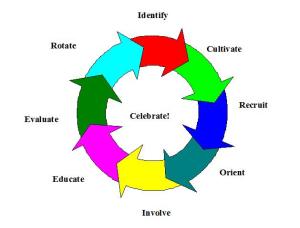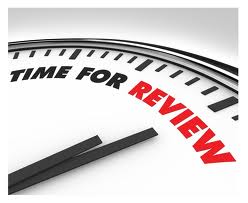Dani Robbins is the Founder & Principal Strategist at Non Profit Evolution located in Columbus, Ohio. I’ve invited my good friend and fellow non-profit consultant to the first Wednesday of each month about board development related topics. Dani also recently co-authored a book titled “Innovative Leadership Workbook for Nonprofit Executives” that you can find on Amazon.com.
 The single most important thing an organization can do to ensure its sustainability is develop its board. You may be thinking — “No Dani, it’s staff, leadership, programming, impact or fundraising” — and all of those things are important, but none of them can happen the way they should without a strong board. Everything flows from a strong board of directors.
The single most important thing an organization can do to ensure its sustainability is develop its board. You may be thinking — “No Dani, it’s staff, leadership, programming, impact or fundraising” — and all of those things are important, but none of them can happen the way they should without a strong board. Everything flows from a strong board of directors.
Strong boards set the mission, vision and values for an organization; they hire the talented and effective CEO and hold that CEO accountable for ensuring and implementing the strategic plan; they raise money, act as the fiduciary responsible agent over the finance and the programming; and they set policy. When it’s done right — like all good leadership — it looks like nothing.
Don’t be fooled, it’s not nothing and it’s not easy.
Board development is the intentional process by which the board is perpetuated, evaluated, and educated. It is usually stewarded by a committee that may be called Governance, Nominating, Administrative or Board Development, and it helps develop an effective board through its two main functions:
 Board Building: A diverse board of directors (thought, skill, race, faith, ability, orientation, age, and gender) that is passionate about the mission of the organization is created through a board building process. That process includes an assessment of the current board and needed skill sets, identification of prospective members, and recruitment and nomination of new board members.
Board Building: A diverse board of directors (thought, skill, race, faith, ability, orientation, age, and gender) that is passionate about the mission of the organization is created through a board building process. That process includes an assessment of the current board and needed skill sets, identification of prospective members, and recruitment and nomination of new board members.- Board Education: Board members will fully understand and can effectively fulfill their commitments to the board of directors when a comprehensive orientation, continuing education, and annual evaluation process is in place.
The Board Development Committee outlines what the organization is looking for in a board member by analyzing current board make-up and identifying future needs, and finding the very best person(s) to meet those needs. In this identification process, the Board Development Committee informs the entire board of what the expectations are for board service.
The Committee reviews the prospects and sets a target number and priority listing of those they wish to bring on at the annual meeting. This list is presented to the board of directors for their comments. Any concerns are directed to the Board Development Committee.
In the absence of concerns, or after such concerns have been addressed, the prospective board member is contacted, preferably by a board member, a committee volunteer, or the person with whom the prospect is most closely affiliated, who requests a time to introduce the prospect to the mission of the organization.
I do not recommend you start the conversation inviting someone to join your board, or even share that you are calling to discuss potential board seats. I recommend you say that you are aware of their interest in the population your organization serves and you’d like to share some of your successes in positively impacting that population. (It may be necessary to assure them you are not setting up the meeting to ask for a gift.) You can decide once you are at the meeting if they are good fit for your board and if you should open the door to discussing a board seat; if not, you can find another way to engage them.

If you decide that you would like to invite them to be considered for a board seat, I recommend you communicate the time, financial obligation and effort expected of all board members before they agree to join.
Time is the principal commitment. Board members should be available at the time the board meets and be prepared to meet as often as is necessary to complete the business of the board during their term of service. They should also be prepared to attend fundraising events and to participate as fully as possible in developing and implementing the resource development plan.
I recommend you do not add someone to your board who cannot attend the meetings; either move the meetings or have them serve in another capacity. Organizations can only carry so many members who cannot attend meetings and most organizations already have a few people who fulfill that role.
Another primary responsibility of the Board of Directors is to ensure financial stability. Therefore, board members are expected to assist with fundraising efforts, as well as personally contribute. The financial health of the organization depends upon people-to-people contact, and prospective board members should understand that identifying and cultivating potential donors is part of their job.
Prospective board members are voted onto the board of directors in accordance with procedures laid out in the organization’s by-laws, which in Ohio are called Codes of Regulation.
Once voted upon, new board members should be oriented. I like to orient board member after they’ve been voted upon but before they’ve been seated. The orientation, either individually or as a group, should be conducted by the Board President, CEO, or Committee Chair. By the conclusion of the orientation, new board members should have a sense of the mission and programs, finances, fundraising initiatives, strategic goals, structure of the board of directors and staff, and their own roles and responsibilities as a member of the Board of Directors. They should also be invited to consider their own goals for service.
Once the Board has been appointed, the Board Development committee moves into its other two roles evaluation and education.

Evaluation is the process of assessing the progress of the board and identifying changes that will bring greater achievement of the organization’s mission. Evaluation is a developmental process, not a report card.
The Board Development Committee will ask individual board members to complete an annual self-assessment, including a section evaluating board process, which the committee will use to complete the board assessment. When a board assessment takes place, the Board Development Committee will compare the board’s individual assessments, identify areas of consensus, and develop a plan of action for strengthening the board.
This process can also include an opportunity for Board members to request trainings. Annual board education is integral to a successful board. There are a variety of training options, an example of some include:
- The Art of the Ask
- Board Process – agendas setting, committee, topics, strategy, structure, engagement
- Basic Board responsibilities (fiduciary and legal)
- Board vs Staff roles
- Best Practices of Effective Boards
- Governance as Leadership: Fiduciary, Strategic and Generative Modes of Governance
I encourage every organization to create a formal plan to annually assess, develop and grow their board. Strength begets strength and strong boards ensure strong, sustainable organizations.


This get’s an A+
I only wish that all Non Profits understood that you’ll never get to the funds without the right people in place! You made my day!
Bob . . . I love it when my blog makes someone’s day. Thanks for sharing your thoughts because now you’ve made my day. 🙂
XOXO ~Erik